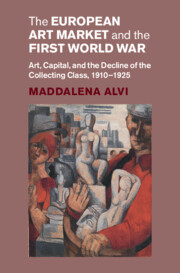 The European Art Market and the First World War
The European Art Market and the First World War Book contents
- The European Art Market and the First World War
- Studies in the Social and Cultural History of Modern Warfare
- The European Art Market and the First World War
- Copyright page
- Dedication
- Epigraph
- Contents
- Figures
- Acknowledgements
- Introduction
- 1 The European Market before 1914
- 2 The Great Conflagration (1914–1918)
- 3 ‘Wartime Cultural Changes’ (1914–1918)
- 4 Postwar Markets (1918–1925)
- 5 ‘The Challenges of New Markets’
- 6 Cementing Nationalisation (1918–1925)
- Conclusion
- Bibliography
- Index
4 - Postwar Markets (1918–1925)
Published online by Cambridge University Press: 10 April 2025
- The European Art Market and the First World War
- Studies in the Social and Cultural History of Modern Warfare
- The European Art Market and the First World War
- Copyright page
- Dedication
- Epigraph
- Contents
- Figures
- Acknowledgements
- Introduction
- 1 The European Market before 1914
- 2 The Great Conflagration (1914–1918)
- 3 ‘Wartime Cultural Changes’ (1914–1918)
- 4 Postwar Markets (1918–1925)
- 5 ‘The Challenges of New Markets’
- 6 Cementing Nationalisation (1918–1925)
- Conclusion
- Bibliography
- Index
Summary
Parallel to Chapter 2, this section reconstructs the socio-economic history of the art market after the First World War. The immediate postwar year, marked by political and economic instability, posed unique challenges for the losers of the war. Germany, in particular, faced hyperinflation, a phenomenon that contributed to accelerate changes initiated by the war. In contrast, the stagnation of the French art market was aggravated after 1918 due to nationalisation, bureaucratisation, and new distribution patterns that only cemented its isolation. Meanwhile, the British market remained relatively stable and less reliant on foreign buyers. The rise of neutral parties’ purchasing power, notably in Switzerland, Sweden, and the Netherlands, highlighted the new dynamics of a fragmented market. Overall, the war altered the trade dynamics of the European art market, with uncontrollable expansion in Germany, French decline, and British stability reflecting its economic impact.
Keywords
- Type
- Chapter
- Information
- The European Art Market and the First World WarArt, Capital, and the Decline of the Collecting Class, 1910–1925, pp. 146 - 181Publisher: Cambridge University PressPrint publication year: 2025
